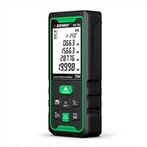Measuring the good and bad inverter with a multimeter
The design process of electronic circuits, engineers inevitably need a multimeter to measure some measuring instruments. Engineers know that multimeter can measure DC current, AC voltage, DC voltage. Inverter, on the other hand, is a device that controls the AC motor by modifying the frequency of the motor's operating power supply. In this article, we will explain to you how to use a multimeter to measure the goodness of an inverter.
It should be noted that for personal safety, you must ensure that the machine is powered off and remove the inverter input power lines R, S, T and output lines U, V, W before operation! First of all, the multimeter to the "secondary tube" file, and then through the multimeter's red pen and black pen according to the following steps to detect:
The black pen contacts the negative pole of DC bus P (+), the red pen contacts R, S, T in turn, record the display value on the multimeter. Then the red pen contacts N (-), the black pen contacts R, S, T in turn, record the display value on the multimeter. If the six display values are basically balanced, it indicates that there is no problem with the inverter diode rectifier or soft-start resistor, on the contrary, the corresponding position of the rectifier module or soft-start resistor is damaged, phenomenon: no display.
The red pen contacts the negative pole of DC bus P (+), the black pen contacts U, V, W in turn, record the display value on the multimeter. Then touch the black pen to N(-), and the red pen to U, V and W in turn, and record the displayed value on the multimeter. If the six display values are basically balanced, it indicates that the frequency converter IGBT inverter module is not a problem, on the contrary, the corresponding position of the IGBT inverter module is damaged, the phenomenon: no output or report a fault.
Drag a power-matched asynchronous motor with the inverter on-site no-load operation, adjust the frequency f, starting from 50Hz down to the lowest frequency.
In this process with an ammeter to detect the motor no-load current, if the no-load current in the frequency drop process is very smooth, can remain basically unchanged, that is a good inverter.
The minimum frequency can be calculated like this, (synchronous speed - rated speed) × pole pair number p ÷ 60. For example, a 4-pole motor, rated speed is 1470 rpm, the minimum frequency = (1500-1470) × 2 ÷ 60 = 1Hz.
No problem with soft start resistor, on the contrary, the corresponding position of the rectifier module or soft start resistor is damaged, phenomenon: no display.
The red pen contacts the negative pole P(+) of the DC bus, the black pen contacts U, V, W in turn, and records the display value on the multimeter. Then touch the black pen to N(-), and the red pen to U, V and W in turn, and record the displayed value on the multimeter. If the six display values are basically balanced, it indicates that the frequency converter IGBT inverter module is not a problem, on the contrary, the corresponding position of the IGBT inverter module is damaged, the phenomenon: no output or report a fault.
Drag a power-matched asynchronous motor with the inverter on-site no-load operation, adjust the frequency f, starting from 50Hz down to the lowest frequency.
This process with an ammeter to detect the motor no-load current, if the no-load current in the frequency decline process is very smooth, can remain basically unchanged, that is a good inverter.
The minimum frequency can be calculated like this, (synchronous speed - rated speed) × pole pair number p ÷ 60. For example, a 4-pole motor, rated speed is 1470 rpm, the minimum frequency = (1500-1470) × 2 ÷ 60 = 1Hz.
AC and DC solid state relay discrimination: usually, in the DC solid state relay shell of the input and output terminals, are marked with "+", "-" symbols, and marked with "Dc input", "DC output", "Dc input", "DC output", "Dc input", "DC output", "Dc output", "Dc input", "Dc output", "DC output", "Dc input", "DC output", "DC output". Dc input" and "DC output". AC solid state relays can only be marked on the input side of the "+", "-" symbol, the output side of no positive, negative points.
Input and output discrimination: no identification of solid state relays, multimeter R × 10k file, by measuring the positive and negative resistance of each pin to discriminate between the input and output. When measured a two-pin forward resistance is small, and reverse resistance is infinite, these two pins that is the input, the remaining two feet for the output. In a smaller resistance measurement, the black pen is connected to the positive input, the red pen is connected to the negative input.
If the measured positive and reverse resistance of the two pins are 0, it means that the solid state relay has been damaged by breakdown. If the measured positive and reverse resistance values of each pin of the solid state relay are infinite, it means that the solid state relay has been damaged by open circuit.






